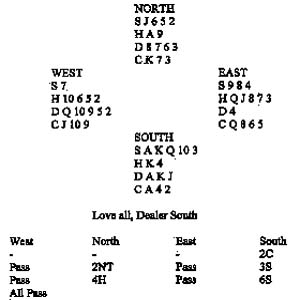|
Bridge
 North
chose to respond 2NT, getting the hand off his chest rather than
struggling to show the values later. South’s 3S showed a suit of at
least five cards and North’s 4H was a cue bid, agreeing spades as
trumps. How would you play the spade slam when West leads the jack of
clubs? The original declarer won with the ace, drew trumps and cashed
the diamond ace. He then crossed to the heart ace and took a diamond
finesse. It was a blow when East showed out but declarer attempted to
recover the situation. He rose with the diamond king, cashed his last
heart and then exited with king and another club. If West had started
with a doubleton club, East would have had to win and concede a
ruff-and-discard. It was not to be. East played low on the third club,
allowing West to win and cash the diamond queen. Do you see how
declarer could have given himself a better chance? After cashing the
diamond ace, he should have played the top two hearts and exited with
ace and another club. If West wins, he will have to lead into the
diamond tenace or concede a ruff-and-discard. If East wins, he will
have no diamond remaining and will have to concede a ruff-and-discard
himself. It is a cost-nothing extra chance. North
chose to respond 2NT, getting the hand off his chest rather than
struggling to show the values later. South’s 3S showed a suit of at
least five cards and North’s 4H was a cue bid, agreeing spades as
trumps. How would you play the spade slam when West leads the jack of
clubs? The original declarer won with the ace, drew trumps and cashed
the diamond ace. He then crossed to the heart ace and took a diamond
finesse. It was a blow when East showed out but declarer attempted to
recover the situation. He rose with the diamond king, cashed his last
heart and then exited with king and another club. If West had started
with a doubleton club, East would have had to win and concede a
ruff-and-discard. It was not to be. East played low on the third club,
allowing West to win and cash the diamond queen. Do you see how
declarer could have given himself a better chance? After cashing the
diamond ace, he should have played the top two hearts and exited with
ace and another club. If West wins, he will have to lead into the
diamond tenace or concede a ruff-and-discard. If East wins, he will
have no diamond remaining and will have to concede a ruff-and-discard
himself. It is a cost-nothing extra chance.
Answer
 Some tournament players
play that a 2D response is strong (forcing) and 3D is weak. This
convention is known as ‘inverted minor-suit raises’. In the
absence of such an agreement, you cannot bid 3D because your hand is
too strong. There is no real alternative but to invent a bid of 2C.
You will then support diamonds on the next round. Not attractive, but
there it is! Some tournament players
play that a 2D response is strong (forcing) and 3D is weak. This
convention is known as ‘inverted minor-suit raises’. In the
absence of such an agreement, you cannot bid 3D because your hand is
too strong. There is no real alternative but to invent a bid of 2C.
You will then support diamonds on the next round. Not attractive, but
there it is!
Awards: 2C-10, 5D-6,
3NT-5, 3D-4.
David Bird
— Knight Features
|